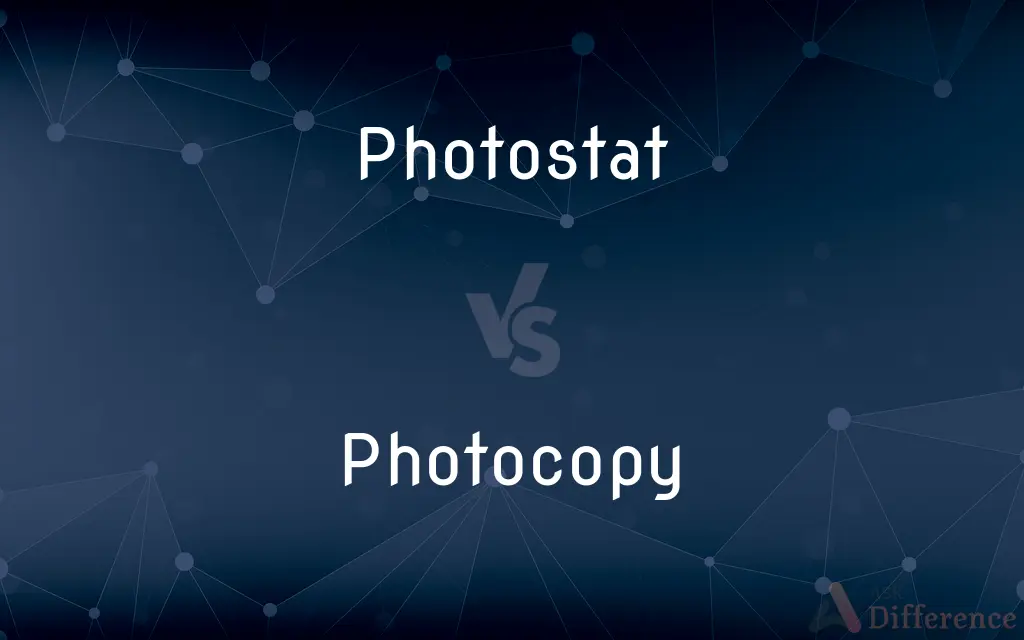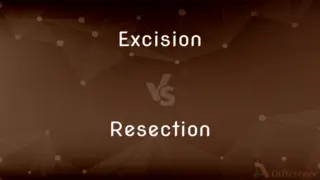Photostat vs. Photocopy — What's the Difference?
By Tayyaba Rehman — Updated on October 9, 2023
Photostat refers to a specific early brand of copying, producing a direct positive or negative image, while a photocopy uses light and toner to reproduce documents on paper.

Difference Between Photostat and Photocopy
Table of Contents
ADVERTISEMENT
Key Differences
Photostat and photocopy, both terms associated with the reproduction of documents, have distinct historical and technical backgrounds. Photostat, a proprietary name, refers to an early 20th-century machine that made direct positive or negative images on sensitized paper through exposure to light. In contrast, photocopy pertains to a more modern method using light-sensitive photoreceptors and toner to replicate documents.
The technology behind Photostat machines is somewhat archaic by today's standards. When using a Photostat machine, an image would be projected onto sensitized paper, creating a duplicate. However, the photocopy process employs a drum that captures an image which then attracts toner particles, transferring them to paper to recreate the document.
Over time, the term "photocopy" has become ubiquitous in describing the act of copying documents, mainly due to the widespread adoption of xerographic machines, commonly known as photocopiers. Conversely, Photostat, while historically significant, has faded into relative obscurity as the technology became obsolete.
It's also worth noting the genericization of brand names. Much like how some brands become synonymous with their product category (think "Kleenex" for tissues), "Photostat" was once a prevalent term for copying. In modern times, however, "photocopy" reigns supreme, representing the action regardless of the machine's brand.
In essence, while both Photostat and photocopy relate to document reproduction, they symbolize different eras and technologies in the evolution of copying.
ADVERTISEMENT
Comparison Chart
Origin
Early 20th-century proprietary name
General term for copying process
Technology
Direct positive or negative images on sensitized paper
Uses light-sensitive photoreceptors and toner
Prevalence
Historically significant but now obsolete
Widespread and commonly used today
Image Quality
Often resulted in one positive and one negative copy
Typically produces positive copies only
Generic Usage
Once a generic term for copying, now specific to an old technology
Commonly used to refer to any document copying, regardless of brand
Compare with Definitions
Photostat
Photostat represented an era before modern photocopying.
Historians appreciate the significance of the Photostat in document preservation.
Photocopy
Photocopy uses toner and light to replicate images.
The photocopy came out clear and sharp.
Photostat
Photostat refers to an early copying method.
She found an old Photostat of the original document in the archives.
Photocopy
Photocopy has become a generic term for copying.
Can you get a photocopy of this report for the meeting?
Photostat
Photostat technology is largely considered outdated.
Few people today have seen an actual Photostat of a document.
Photocopy
Photocopy is a process of reproducing documents.
She made a photocopy of her passport for the records.
Photostat
Photostat is a brand name turned generic term.
The library still has a Photostat machine on display.
Photocopy
Photocopy machines are common in offices.
The office had a dedicated room for the photocopy machine.
Photostat
Photostat machines create direct images on sensitized paper.
The Photostat produced both positive and negative copies.
Photocopy
Photocopy technology is widely adopted globally.
Photocopy shops can be found in almost every city.
Photostat
A photographic device for making positive or negative copies of graphic matter.
Photocopy
To make a photographic reproduction of (printed or graphic material), especially by xerography.
Photostat
A copy made with such a device.
Photocopy
A photographic or xerographic reproduction.
Photostat
(dated) A photocopy, especially one made by a Photostat machine.
Photocopy
A copy made using a photocopier.
Photostat
A photocopy made using a photocopier.
Photocopy
To make a copy using a photocopier.
Photostat
Positive (black on white) or negative (white on black) reproduction of printed matter or artwork made on a photostat machine, which uses photographic paper instead of a transparent negative, and uses a prism to render the paper negative readable instead of reversed.
Photocopy
A photographic copy of written or printed or graphic work
Photostat
(transitive) To make such a photocopy of.
Photocopy
Reproduce by xerography
Photostat
A photocopy made on a Photostat machine
Photostat
A duplicating machine that makes quick positive or negative copies directly on the surface of prepared paper
Photostat
Make a copy by means of a Photostat device
Common Curiosities
Is Photostat still commonly used today?
No, Photostat machines are now largely obsolete, replaced by modern photocopying methods.
What's the primary technology difference between Photostat and photocopy?
Photostat created direct images on sensitized paper, while photocopying uses light-sensitive photoreceptors and toner.
Why don't we see Photostat machines anymore?
Photocopying technology, being more efficient and versatile, has rendered Photostat machines obsolete.
Was Photostat a brand name?
Yes, Photostat was a proprietary name, but it also became a generic term for copying.
Are the terms interchangeable?
While both relate to copying, "photocopy" is more prevalent today, and "Photostat" refers to an older technology.
Can photocopying produce color copies?
Yes, modern photocopy machines can produce both black-and-white and color copies.
Was the quality of a Photostat copy comparable to a photocopy?
Photostat copies often resulted in one positive and one negative copy, while photocopies typically yield clearer, positive reproductions.
Do Photostat copies have historical value?
Yes, Photostat copies can hold historical significance, especially when they preserve old, irreplaceable documents.
Can the word "photocopy" refer to digital copying as well?
While "photocopy" traditionally refers to paper copies, it's sometimes colloquially used for digital reproductions.
How has digital technology impacted photocopying?
Digital technology has enhanced photocopying, allowing for features like scanning to email, digital storage, and more.
Why did photocopying surpass Photostat in popularity?
Photocopying offers more versatility, efficiency, and clearer reproductions, leading to its widespread adoption.
Can I use the term "xerox" interchangeably with "photocopy"?
While "xerox" is a brand and has been used colloquially to mean photocopy, it's always best to use the generic term "photocopy" to avoid brand specificity.
Are there still places that repair Photostat machines?
Very few, if any, since the technology is largely considered antiquated.
Were Photostat machines bulky?
Yes, early Photostat machines were relatively large and cumbersome.
Are photocopy machines harmful to the environment?
While photocopy machines can have an environmental impact, especially regarding paper and energy usage, many modern machines have eco-friendly features to mitigate this.
Share Your Discovery

Previous Comparison
Excision vs. Resection
Next Comparison
Verve vs. PanacheAuthor Spotlight
Written by
Tayyaba RehmanTayyaba Rehman is a distinguished writer, currently serving as a primary contributor to askdifference.com. As a researcher in semantics and etymology, Tayyaba's passion for the complexity of languages and their distinctions has found a perfect home on the platform. Tayyaba delves into the intricacies of language, distinguishing between commonly confused words and phrases, thereby providing clarity for readers worldwide.















































